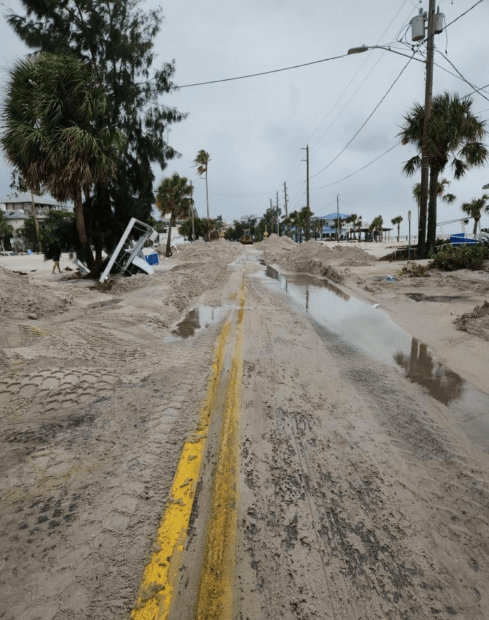We have much more to do and your continued support is needed now more than ever.
Hurricanes, Climate Change, and Finding the Path Forward on the Gulf Coast

I know hurricanes. As a Coast Guard kid, I grew up on the Chesapeake Bay, Outer Banks and Caribbean, and my adulthood has found me always near the water I love so much, too. I have lived the last two decades on the Gulf Coast, between New Orleans and Tampa Bay.
While I have lost count of the hurricanes I’ve been impacted by and how many times I’ve evacuated, I distinctly remember losing our home to Hurricane Emily while I was in middle school—after evacuating to an inland hotel, and later seeing our decimated neighborhood on national news via helicopter footage.

Climate anxiety
But in the last month, I found myself moving into a realm of anxiety about storms and climate change that even I have never experienced. I live in St. Petersburg, Florida, a breathtakingly beautiful city with some of the best beaches in the world.
Our vibrant community and wildlife haven with postcard views and picture perfect sunsets was decimated by three hurricanes this season—two major hurricanes in a matter of weeks. Both Hurricanes Helene and Milton are anticipated to be deemed “truly historic events”—in the rankings with catastrophic storms like Katrina, Sandy, and Harvey.
If you know about storms, you know that each storm is different. Hurricanes Helene and Milton were brutal to our community in different ways—Helene bringing massive storm surge, Milton bringing extreme winds and flash flooding. Those beautiful beaches? Catastrophically damaged. Communities soggy with belongings strewn into the streets. Trees on houses. Boats in parking lots.
We had barely begun to get ourselves together from Helene before Milton hit. My son lost his middle school to storm surge in Helene, and we were just beginning to figure out how to adjust to that upheaval when schools let out again for Milton. My friends were bravely picking up pieces from the surge that destroyed their homes when they had to flee from Milton.

City officials wrote heartbreaking posts about running out of time to collect Helene debris—people’s entire home of belongings piled on their lawns—as another major storm steered toward the city. Several people told me they were physically ill in the days before and after the storm—sick with worry.
How brave and tireless do you have to be to live on the Gulf Coast these days? Storms are stronger and they are more frequent. Is this the new normal? When will the next one hit? That is what scares me. I have a healthy respect for storms, growing up in their cones of uncertainty, and I’ve spent my career raising awareness about coastal vulnerability and building resilience, but this 2024 hurricane season was eye-opening and alarming in a new way.
We are living the trauma of a changing planet. I felt climate change impacts more acutely this past month than ever. After the second storm, there was much less communication among my friends and family in the impacted areas than after the first storm. I felt that myself. I didn’t want to talk. I knew where my people were evacuated. I kept tabs as best I could. But it took over a week for many of us to really check in or post on social media about what we’d experienced. We were too tired and beat down from a double-wollop in a hurricane season that was unimaginably next level.
Moving forward through climate disasters
What comes next? I admit that I struggle to think about this as I’m still processing the storms. What I do know, from working in post-Katrina New Orleans and other tattered communities, is that I hope we can find the collective strength to be thoughtful and wise about how we recover and how we rebuild.
Because of these devastating storms, we have many decisions before us about how we invest in our communities. How do we best live with nature? How do we reduce our risk? How do we take action to reduce further climate impacts? These questions beg for good answers and urgent action.

The good news is, before the storms, we talked with hundreds of people in St. Pete and across Tampa Bay about building resilience in the face of a changing climate and we even made a short film about it, called “Dear Tampa Bay”. We studied stakeholder engagement on these pressing coastal issues.
We found that people across Tampa Bay—from the faith community to the business community to local governments to students—want to work together with their communities and decision-makers to improve their resilience to a changing climate. They want to protect their communities and make good decisions for their families and their safety. We know this to be true across the Gulf Coast, and we know that we can rebuild smarter and we can restore our natural areas. We can and should prioritize resilience in our communities because it impacts all of us. We are weary, but we are also poised to rise up and create stronger and safer communities.
NWF’s Gulf Program has long been committed to building coastal resilience along the Gulf Coast by working with communities and experts to grow awareness, guide decision-making, and create safer futures. Your support is important!
Learn more about our work and how you can participate in building resilience along the Gulf.


















